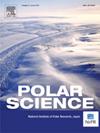Nutrient dynamics and biogeochemical processes at the Polar front of Indian sector of the Southern Ocean: Influence of Circumpolar deep water intrusion
IF 2
4区 地球科学
Q3 ECOLOGY
引用次数: 0
Abstract
The Circumpolar Deep water (CDW) is one of the largest water masses in the Southern Ocean. The cross-frontal flow of the CDW is a vital mode of redistribution and transport of heat, salts, nutrients, etc. in the ocean. The present study aims to understand the role of the CDW intrusion on nutrient dynamics and biogeochemical processes at the Polar frontal region. The study noted a patch of high nutrients layer at ∼300–400 m in the Polar Front-II, underlying the dicothermal layer or the temperature minimum layer. This high nutrient patch was attributed to the intrusion of the CDW at the Polar front, influencing the physico-chemical processes in the water column. It was evident that, the density gradient, stratification and overall, the combined effect of physico-chemical and biological factors as a consequence of intrusion of the CDW contributed to the formation of the high nitrate patch at the Polar Front-II. Even though, the CDW intrusion did not significantly impact the photic layer dynamics during this study, the possible barrier effect during austral summer contribute to the formation of the high nitrate layer. This feature may be responsible for trapping nutrients in the subsurface due to stratification, and made available to the photic region via upwelling processes, consequently triggering changes in the biological community structure and biogeochemical processes.
南大洋印度板块极地锋的营养动态和生物地球化学过程:环极深水入侵的影响
环极深水(CDW)是南大洋最大的水团之一。CDW的横锋流是海洋中热量、盐、营养物质等再分配和运输的重要方式。本研究旨在了解CDW入侵对极地锋区营养动态和生物地球化学过程的影响。该研究指出,在极地锋- ii的约300-400米处有一块高营养层,位于双温层或最低温度层之下。这一高营养物斑块是由于极地锋的CDW入侵,影响了水柱的物理化学过程。结果表明,由于CDW的入侵,密度梯度、分层和总体上物理化学和生物因素的综合作用促成了极锋高硝酸盐斑块的形成。尽管在本研究中,CDW入侵对光层动态没有显著影响,但南方夏季可能存在的屏障效应有助于高硝酸盐层的形成。这一特征可能是由于分层作用而将营养物质困在地下,并通过上升流过程进入光区,从而引发生物群落结构和生物地球化学过程的变化。
本文章由计算机程序翻译,如有差异,请以英文原文为准。
求助全文
约1分钟内获得全文
求助全文
来源期刊

Polar Science
ECOLOGY-GEOSCIENCES, MULTIDISCIPLINARY
CiteScore
3.90
自引率
5.60%
发文量
46
期刊介绍:
Polar Science is an international, peer-reviewed quarterly journal. It is dedicated to publishing original research articles for sciences relating to the polar regions of the Earth and other planets. Polar Science aims to cover 15 disciplines which are listed below; they cover most aspects of physical sciences, geosciences and life sciences, together with engineering and social sciences. Articles should attract the interest of broad polar science communities, and not be limited to the interests of those who work under specific research subjects. Polar Science also has an Open Archive whereby published articles are made freely available from ScienceDirect after an embargo period of 24 months from the date of publication.
- Space and upper atmosphere physics
- Atmospheric science/climatology
- Glaciology
- Oceanography/sea ice studies
- Geology/petrology
- Solid earth geophysics/seismology
- Marine Earth science
- Geomorphology/Cenozoic-Quaternary geology
- Meteoritics
- Terrestrial biology
- Marine biology
- Animal ecology
- Environment
- Polar Engineering
- Humanities and social sciences.
 求助内容:
求助内容: 应助结果提醒方式:
应助结果提醒方式:


